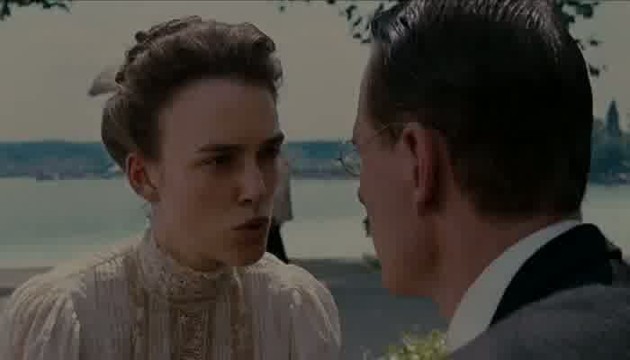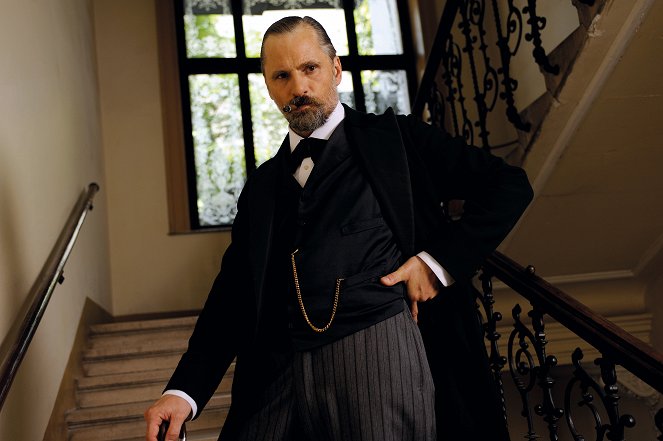Réalisation:
David CronenbergPhotographie:
Peter SuschitzkyMusique:
Howard ShoreActeurs·trices:
Michael Fassbender, Keira Knightley, Viggo Mortensen, Vincent Cassel, Sarah Gadon, Katharina Palm, André Hennicke, Arndt Schwering-Sohnrey (plus)VOD (4)
Résumés(1)
Zurich, 1904. Carl Jung, 29 ans, psychiatre, est au début de sa carrière et partage sa vie avec sa femme, Emma. S’inspirant des travaux de Sigmund Freud, Jung tente le traitement expérimental connu sous le nom de psychanalyse sur Sabina Spielrein, âgée de 18 ans. Sabina, jeune Russe cultivée qui parle l’allemand, a été diagnostiquée « hystérique », et a la réputation d’être agitée et violente. Lors de ses séances avec Jung, elle expose une jeunesse gâchée par les humiliations et une composante sexuelle sado-masochiste. Grâce à leur correspondance, Jung parvient à une grande complicité intellectuelle avec Freud, sur le cas de Sabina. Freud demande à Jung de traiter un collègue, Otto Gross, toxicomane et amoraliste impénitent. Sous son influence, Jung va balayer sa propre éthique et se laisser aller à son attirance envers Sabina. C’est le début d’une liaison dangereuse dont les conséquences vont être aussi inattendues que fondamentales. (Mars Distribution)
(plus)Vidéo (21)
Critiques (12)
Je me ferais un plaisir de jouer avec Mademoiselle Spielrein et de fumer un cigare avec Freud, mais je préférerais m’asseoir tranquillement au bord du lac de Zurich plutôt que d’assister aux conversations languissantes avec Jung le malléable et l'indécis. Viggo Mortensen assure et l’esthétique de l’image est savoureuse, mais où est l’émotion ? Ici, on regarde des stars de cinéma grand public qui récitent des phrases non compréhensibles par la plupart des spectateurs. Par contraste, Lunes de fiel par Roman Polanski était bien plus poétique et passionné dans son témoignage sur les recoins sombres de la sexualité humaine.
()
Sinfully unexciting. Formally, A Dangerous Method is a film with very little to reproach, and it will probably delight film theorists, but I’d be lying to myself if I gave it a higher rating. I just didn’t like it, I didn’t find it interesting in the least and the idea of having to watch it again is pretty terrifying. Cronenberg’s old perversion and subversiveness have disappeared under a ton of academically precise make-up, and now just bubble peacefully deep beneath the surface. And looking for it is not fun.
()
A rather logical step (forward) in Cronenberg's filmography. From practice, i.e. obscure, low-budget independent horror movies (Shivers, Rabid, The Brood), and obscure, bigger-budget horror movies (Videodrome, The Dead Zone, The Fly), the director worked his way up to theory and started making polished dramas with capital from major Hollywood studios. The subversiveness of the earlier metaphysical body horror movies (a genre for which he holds the copyright) has not disappeared from his more recent films, but it is more artfully hidden and thus all the more dangerous. Just like the dark ideas. Safely tucked away in our subconscious until two gentlemen began to ferret them out at the beginning of the 20th century. Contemporary observers perceived the method employed by the fathers of psychoanalysis as talk therapy. Patients talked; Freud and Jung listened. The Dangerous Method adopts this approach, but with the difference that Freud and Jung talk through most of the film while we listen. Cronenberg’s favourite themes of sexual repression and the destructive power of sexual desire are addressed using a straightforward yet refined vocabulary and subtle hints. The most fascinating development takes place in the case of the father-son relationship between two men for whom each other’s existence gradually becomes both a driving force and something that they would rather deny. In the spirit of the axiom that a doctor must get sick in order to know what illness he is treating, The Dangerous Method is a clinical study of an unorthodox love triangle. The base of that triangle is Jung, a man with an admirable appetite who, with regard to others, does not place restrictions on himself either in terms of food (with Freud’s family at the table) or in terms of sex (he clearly feels no remorse for his infidelity). More than for himself, this egoism is thus destructive for the other two crucial people in his life, i.e. for Sabina, who undergoes a convincing transformation from a patient to a doctor (see the first and last shots of the film), which is critical for the plot, as well as for Freud. We peculiarly see Jung with them only on the boat that his wife gives him. For viewers who are familiar with basic psychoanalytical concepts, the comprehensibly composed Freudian symbolism provides a guide for finding one’s bearings in the labyrinth of desires that the characters allow themselves to be controlled by (Otto Gross, libido personified, could be Jung's unbridled id, whereas the authoritative Freud represents his restrictive superego). The Dangerous Method is a drama that is thoroughly well thought out on at least two levels, where the upper level – understanding – reveals the director’s mastery of the classic narrative style. No editing goes to waste, the composition of the shots is impressively economical thanks to the great depth of field, the placement of the characters in space reflects the relationships of voluntary and forced subordination and dominance between them, the narrative is fluid and focused, and the intertwining of the romantic and professional storylines is almost perfect. With this film, I believe the Canadian eccentric has advanced to the category of great directors. 85%
()
(moins)
(plus)
So, let’s sum it up. What we have here is a movie where the main parts are Carl Jung and Sigmund Freud. And on top of that we have this crazy girl, who had won a windfall in her life and is now making up for it with sexual deviation. The setting – both Zurich and Vienna – is more than nice. And last but not least, there is a cast of actors in which one is better than the other. Judge for yourselves: Viggo Mortensen, Michael Fassbender, Keira Knightley or Vincent Cassel. That’s quite a cast of actors, isn’t it? But David Cronenberg lays it on you in the first minute that you immediately have to stop and think about whether Keira is serious about acting or whether she should maybe call it quits after this film and disappear into another area of art. And then you also realize that even though Jung and Freud are quite interesting characters from history, you will be so bored with them that even your ninety-year-old grandma whose only hobby is to feed her chickens twice a day could not be more dull. I’d been looking forward to an interesting premise and what I got was utter disappointment in all respects. At first sight, it’s such an interesting movie, but at second sight you won’t believe it a corner of the street in Vienna, let alone Zurich.
()
Cronenberg gives a brief insight into the core ideas of Freud and his pupil Jung in an audience-friendly and simple form, which is a rare and welcome gift compared to complexly worded lectures on psychoanalysis or literary scholarly attempts to interpret their work. Yet, thanks to the breathtaking performances of all three leading characters and the masterfully written dialogues that often provide a hidden point, I find Cronenberg's film also attractive for the audience.
()



Annonces